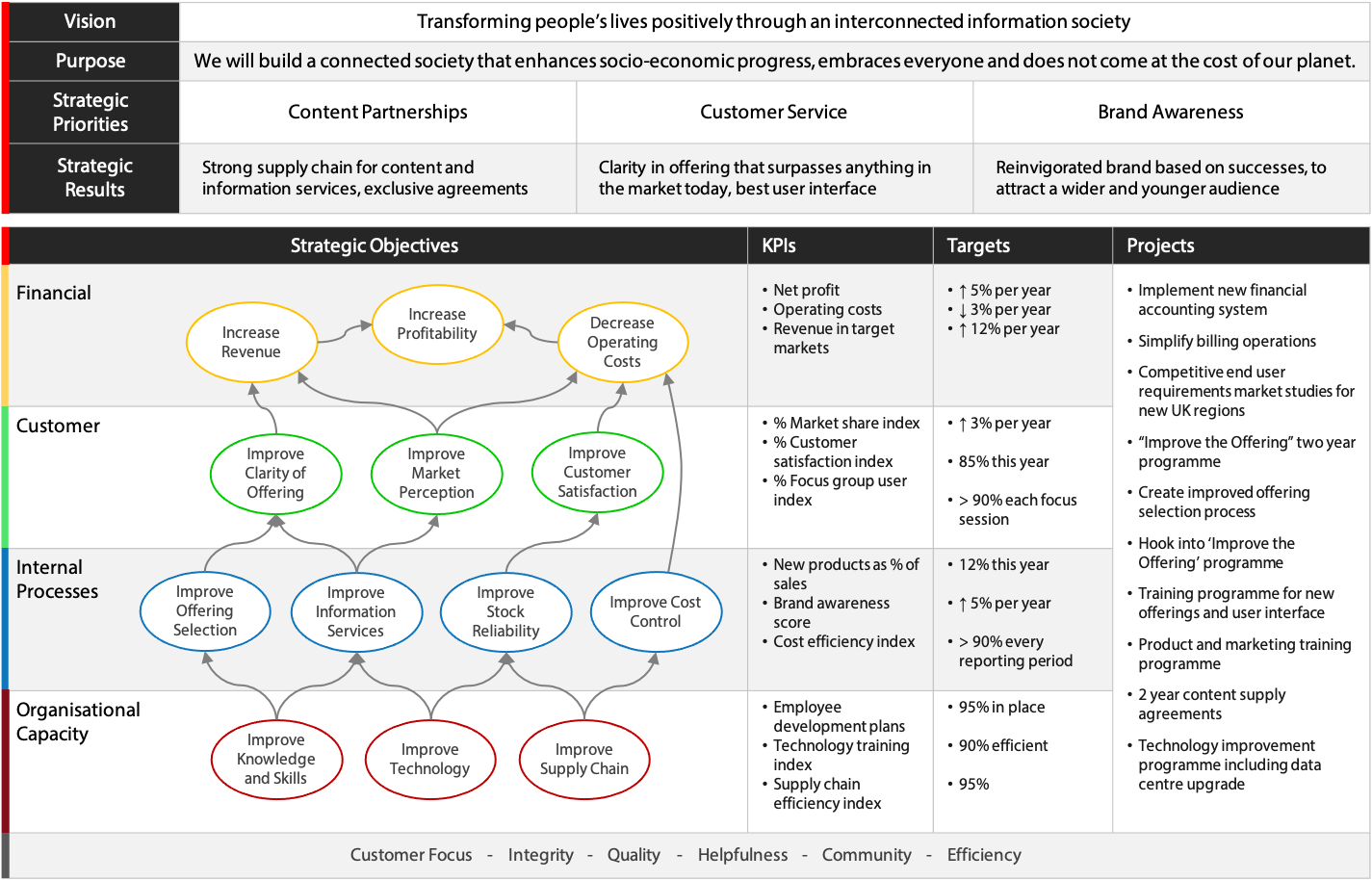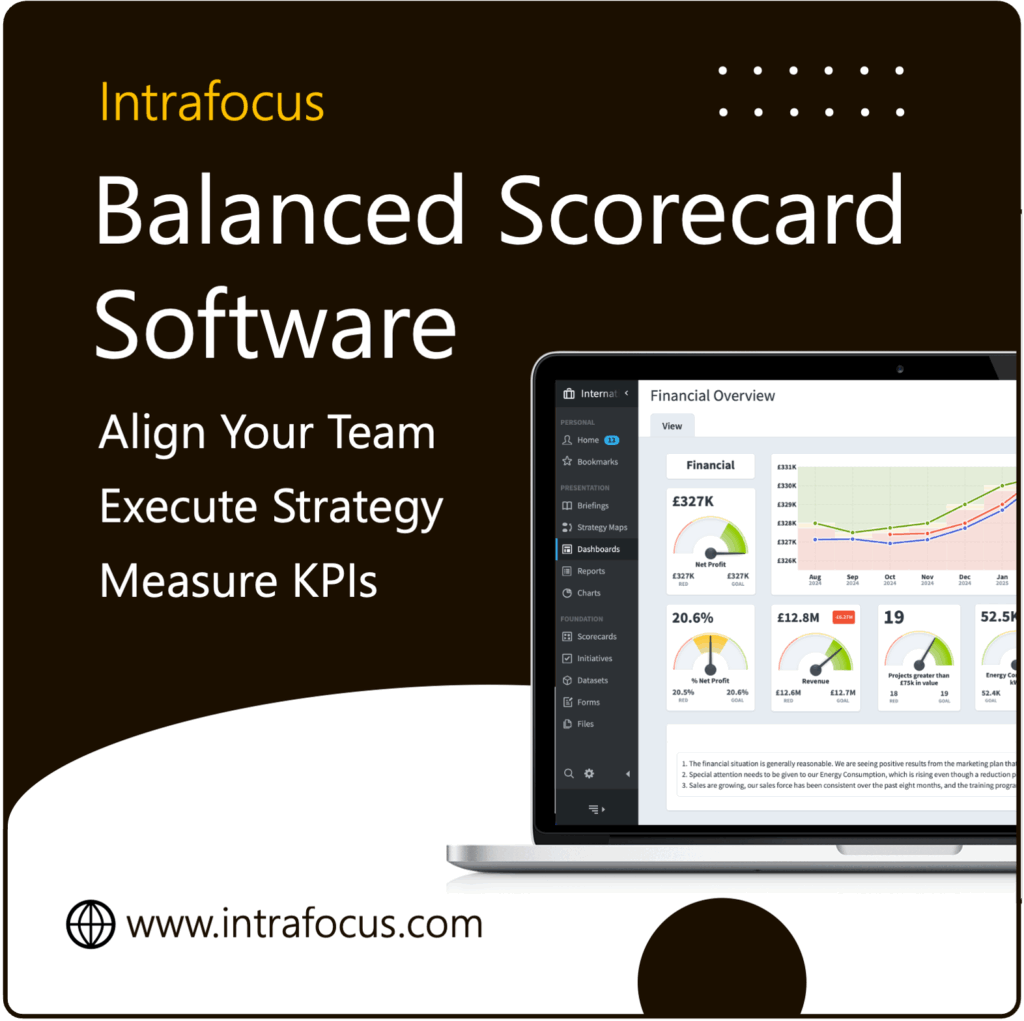Strategy Without Engagement Is Just a Dream
Cascading strategy maps. Let’s be honest: Strategy often gets stuck in the boardroom. A select group of executives spend months developing a plan, polishing it into a glossy document, and then sending it downstream with the hope that everyone just “gets it.” But that’s not how strategy works.
One of the toughest parts of implementing a Balanced Scorecard isn’t defining the strategy. It’s getting everyone in the organisation to understand and act on it. Communication usually breaks down from the document to action. Employees don’t wake up in the morning thinking about top-level KPIS or strategic pillars. They care about their teams, their goals, and their deliverables. If those aren’t clearly linked to the bigger picture, the strategy becomes a poster on the wall. Well-intentioned but ultimately ignored.
The real secret to success? Cascading your Strategy Map. It’s not enough to have a single corporate view. You need a way to help each department, division, and team build their version of the map that makes sense to them but still supports the organisation’s primary objectives.
When done right, cascading strategy maps create a sense of ownership. People can see how their work contributes. It stops being the company’s strategy and starts becoming our strategy. That shift in mindset is everything.
Related: Balanced Scorecard software from Intrafocus — the official EMEA supplier of Spider Impact.
At Intrafocus, we’ve seen repeatedly that the Balanced Scorecard only works when strategy becomes part of everyday language. Cascading Strategy Maps are the most powerful tool for making that happen.
What Is a Strategy Map?
Before diving deeper, let’s quickly clarify what a Strategy Map is and why it’s more than just a diagram.
A Strategy Map is a visual representation of your organisation’s strategic objectives, typically structured across four perspectives:
- Financial – What success looks like to shareholders
- Customer – How do you deliver value to those you serve
- Internal Processes – What you need to excel at internally
- Organisational Capacity – The tools, people, and culture that support it all
Each objective is linked with arrows, showing cause and effect. It’s not just “nice to have.” It tells a story. It shows the flow from investment to outcome, from behaviour to result.
This matters because it forces focus. Instead of trying to improve everything (and ending up improving nothing), your teams understand where to direct their energy. It aligns your people, processes, and resources around what matters.
But this is important; it can’t stop at the executive level. A single corporate Strategy Map is a good start, but it’s not the finish line. Just like you wouldn’t give a one-size-fits-all uniform to every department, you can’t expect a single map to guide every team.
That’s where cascading comes in. Each department or unit needs a tailored map, built with the same principles but tuned to reality. The result? A set of interconnected maps that create one cohesive, strategic organisation.
And when everyone’s working from the same playbook, that’s when the magic happens.
Cascading Strategy Maps Means Alignment
So what exactly does “cascading” mean in this context?
Put simply, cascading a Strategy Map means breaking down the high-level strategy into meaningful, actionable components at every level of the organisation. It’s not just duplication. It’s interpretation. It’s context. It helps each team understand how their work supports the bigger picture and gives them a map to navigate.
Here’s a simple example. Let’s say your corporate objective is to “Improve Customer Satisfaction.” That’s great, but vague. For the Finance team, it might translate into “Streamline invoicing to reduce billing errors.“ For the Customer Service team, it could be “Resolve 90% of support tickets within 24 hours.“ These contribute to the same high-level goal, but the path is tailored to the team.
When cascading is done well, it creates alignment without micromanagement. Departments aren’t just told what to do—they’re empowered to figure out how to contribute. That’s a massive shift in accountability.
And here’s the real kicker: when people create their own Strategy Maps, they engage with the strategy on a deeper level. It’s no longer an abstract plan from above. It becomes part of their daily decision-making.
There’s also a cultural benefit. Cascading Strategy Maps encourage cross-departmental collaboration. Teams begin to understand the interdependencies between their goals and others’. It becomes clear that strategy isn’t a solo sport—it’s a team game.
At Intrafocus, we often advise clients to treat the cascading process not as an administrative task, but as a strategic conversation. Done right, it’s one of the most valuable exercises your organisation can undertake. It reveals blind spots, clarifies priorities, and brings your people on board.
If your strategy feels stuck at the top, cascading could be the secret sauce you’ve been missing.
Common Challenges When Cascading Strategy Maps
Cascading Strategy Maps sound great in theory, but implementation is not always smooth sailing. Many organisations stumble during implementation because translating strategy into actionable goals at every level takes more than good intentions.
Here are some of the most common hurdles—and how to get past them:
1. “We don’t have time for this.”
Yes, cascading strategy maps takes time upfront, but it saves months of confusion later. A clear, aligned strategy means fewer course corrections, better decisions, and more accountability. It’s not a delay—it’s an investment.
2. “Our teams aren’t strategic thinkers.”
Don’t underestimate your people. Most employees have valuable insights about what needs to improve. When guided through the process with the proper support, they’ll rise to the occasion—and often surprise you.
3. “We already have KPIS. Isn’t that enough?”
Measures without context are like a compass without a destination. Strategy Maps provide the “why“ behind the “what.“ You need both to navigate effectively.
4. “Every department wants to do it differently.”
That’s a good thing—if managed well. Strategy cascading isn’t about enforcing sameness; it’s about strategic coherence. Encourage departments to tailor their maps, but always link them to overarching goals.
5. “We lose momentum after launch.”
Cascading isn’t a one-off event. Build in review cycles, use software to track updates, and keep the conversation alive in leadership meetings.
Overcoming these challenges doesn’t require a new playbook—it just requires commitment, communication, and clarity.
Why Measures Come Last (Even If That’s Uncomfortable)
Let’s get something out of the way: we love KPIS. Everyone does. They’re comforting. They give us something solid to grab onto: numbers, charts, and targets—things we can track, things we can improve.
So it’s no surprise that many organisations start their Balanced Scorecard journey with measures. After all, if you can measure it, you can manage it, right?
Well, not exactly.
Jumping straight to KPIS is like putting up a scoreboard before agreeing on the game. What are you measuring? What’s the objective? How does it link to the bigger picture?
If your teams create KPIS without a strategy map, they risk measuring what’s easy rather than important. The result is a dashboard full of noise and very little insight.
That’s why the measures should come last. Once you’ve developed a clear Strategy Map, whether at the corporate or departmental level, you can identify the right objectives and then ask: How will we know if we’re succeeding?
Now, we’re not being rigid purists. In the real world, things don’t always happen in perfect sequence. Some departments may already have measures in place before they formalise objectives. That’s okay. The key is recognising that strategy gives meaning to measurement.
Kaplan and Norton would agree: a Strategy Map is your hypothesis, and the balanced scorecard is how you test it.
So, resist the temptation to jump to numbers. First, clarify the goals. Then connect the dots. Then measure. Your reports and your results will be infinitely better for it.
Make It Work: Practical Tips for Your Organisation (with a Little Help from AI)
You’ve got the theory—now let’s talk practice. Here’s how to bring cascading Strategy Maps to life in your organisation:
- Start with a clear corporate map: Gather your leadership team and agree on the top-level strategic objectives. Make sure they align with your mission, vision, and values.
- Invite departments to build maps: Don’t write down a to-do list. Instead, workshops should be held where managers and teams create strategy maps relevant to their functions but still linked to the corporate strategy.
- Focus on alignment, not duplication. Cascading doesn’t mean copying objectives down the chain. It means translating them into the local language and context. Ask each team, “How do we contribute to this goal?”
- Make it visible and living: Use a strategic performance tool like Spider Impact to create, track, and update Strategy Maps across the business. This avoids “PowerPoint paralysis“ and keeps your strategy alive.
And here’s where AI steps in.
Modern strategy tools are getting smarter. AI can analyse thousands of objectives across departments, highlight areas of misalignment, and even suggest adjustments. It can flag when certain KPIS aren’t supporting any strategic objective, or an objective has no precise measure.
It doesn’t replace human thinking, but it amplifies it. Think of it as a strategy assistant that never sleeps.
In short, cascading Strategy Maps connect people to purpose. Add an innovative tool such as Spider Impact, and you have a strategy execution machine that runs on clarity, engagement, and real-time insight.




